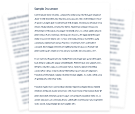Variation of Discretionary Trust
Create your document of Discretionary Trust terms quickly with instant document builder of Lawpath. Create quality documents easily. Try it now!
4.6 (157 reviews)
Last updated November 18, 2025
Under 10 minutes
Suitable for Australia
Written by Edwin Montoya Zorrilla
Reviewed by Damin Murdock
Document Overview
This Variation of Discretionary Trust Deed is a document that you can use to change the terms of an existing discretionary trust. The document is to be executed as a deed by the trustee and appointer, as provided for in the original trust deed for the discretionary trust. You MUST seek advice from a qualified professional before using this deed to check that it meets your specific circumstances.
Note: this document assumes that the current trustee is the trustee appointed by the original trust deed.
Can you change/remove the beneficiaries of a discretionary trust?
Yes, as the trustee of a discretionary trust in Australia, you can change or remove beneficiaries at any time, as long as the trust deed allows for it. This is one of the key features of a discretionary trust, as it provides flexibility in managing the trust’s assets and distributing income.
However, it’s important to note that any changes made to the trust deed must be done in accordance with the trust’s deed and legal requirements. Seeking legal advice from a qualified professional is strongly recommended before making any changes to the beneficiaries of a discretionary trust.
Who is the primary beneficiary of a discretionary trust?
The primary beneficiary of a discretionary trust is any person or entity who is named in the trust deed. There can be multiple primary beneficiaries. The trust may also list “general” or “secondary” beneficiaries, who are people not named but referenced by their relationship to primary beneficiaries, such as children or spouses. The trustee has discretion over how to distribute income or capital between these beneficiaries, depending on the instructions within the trust deed and those beneficiaries’ individual circumstances.
The Legal Risk Score of a Variation of Discretionary Trust Template
Our legal team have marked this document as high risk considering:
- Amendments made to the trust deed might inadvertently affect the interests of beneficiaries who were previously entitled, despite stipulations intended to prevent such outcomes.
- The document allows for alterations to the trust deed which, if not carefully considered and executed, could potentially conflict with existing laws or rules, such as those against perpetuities.
- The document generally deals with large amounts of asseys and could have tax implications.
Users familiar with trust operations and the specific terms of the original trust deed are likely to navigate these risks more effectively, but should still proceed with caution and consider seeking professional advice to ensure the changes align with legal requirements and their personal or fiduciary goals.

Variation of Discretionary Trust Checklist
Complete your free Variation of Discretionary Trust with our checklist
Ensure Proper Execution
All parties involved must sign the deed to validate the amendments as stipulated.
Record and Store the Document
Keep a secure and accessible record of the executed deed alongside the original trust deed for legal and administrative reference.
Notify Beneficiaries
Inform all beneficiaries of the trust about the changes to ensure transparency and avoid any disputes or misunderstandings.
Review Compliance
Regularly review the amended trust deed to ensure ongoing compliance with laws and rules, particularly those against perpetuities, to avoid legal challenges.
Use this Variation of Discretionary Trust if:
- A discretionary trust has previously been established;
- The trustee is permitted to amend the trust deed; and
- The changes to the trust deed are to be formalised, as set out in a deed of variation.
What does the Variation of Discretionary Trust cover?
- The changes to the trust deed; and
- Relevant consents and other consequential terms.
Other names for Variation of Discretionary Trust include:
- Deed of Variation of Discretionary Trust; and
- Change of Discretionary Trust.
Further information
View Sample Variation of Discretionary Trust
It's never been so easy
Sign-up to a free Lawpath account
Get started and we'll take care of you. It's that easy.
Browse our 500+ legal documents
Browse our 500+ legal documents to find the perfect match to cover your business needs. We've got Compliance, Employment, Service agreements and more.
Collaborate with e-Sign and Sharing
Having access to your legal documents has never been easier. You can request e-signature, share the document and download for an efficient collaboration.
Create unlimited legal documents and eSignatures for only $39/month.
Upgrade to a Lawpath legal plan to boost your new business.


Here's what people say about Lawpath's Variation of Discretionary Trust
Reviews are managed by BazaarVoice and comply with the BazaarVoice Authenticity Policy. Reviews are independently verified by BazaarVoice and detail our customers' real experiences.
0 reviews
Most Recent
Highest to Lowest Rating
Lowest to Highest Rating

